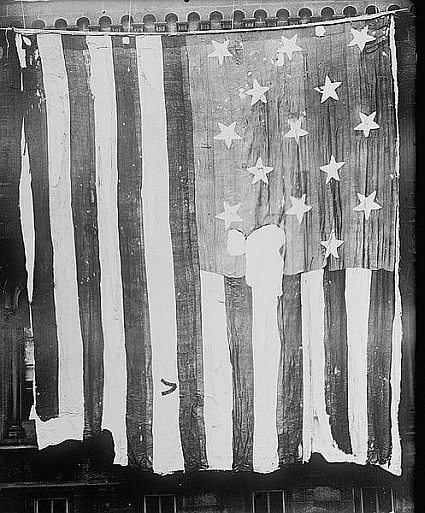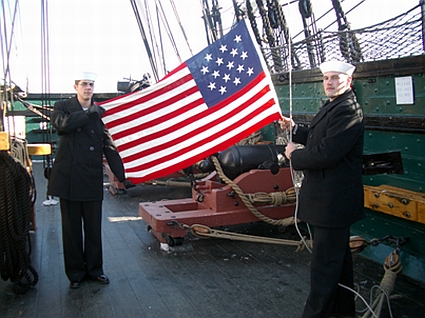The Star Spangled Banner
Between the years 1795 and 1818 is the only time when the U.S. flag had more than thirteen stripes. Recognizing the addition of Kentucky and Vermont, the new flag enlarged to fifteen stars and fifteen stripes. This was the flag of a newly independent nation struggling to keep it newly won freedom.

The Star Spangled Banner Flag.
The battleship USS Constitution flew this flag defending American vessels and asserting U.S. sovereignty in battles against the Barbary pirates. Ultimately, the Constitution defeated several British warships during the War of 1812. She earned the nickname “Old Ironsides” when British shells seemed to bounce of her hull. Today, the USS Constitution is the oldest commissioned battleship afloat. She may be visited at Charlestown Navy Yard at the end of Boston’s Freedom Trail. United States Flags may be flown for individuals from the ships riggings. Make requests to the ship’s Flag Coordinator found on the USS Constitution’s official Web site. A certificate signed by the ship’s commander to record the event will be returned with the flag.
During the Battle of Baltimore in the same war, the flag gained its endearing name, “The Star Spangled Banner.” Poet Francis Scott Key coined the name as he penned our national anthem, “and the star-spangled banner in triumph shall wave o’er the land of the free and the home of the brave!” Key saw the huge flag flying over Fort McHenry on the morning after the battle. He knew the fortress had not surrendered, and he found inspiration to write the beloved poem. Fort McHenry may be visited today in Baltimore’s harbor. A reproduction of the Star Spangled Banner flies over the star shaped fortress.

Sailors aboard USS Constitution raise 15 star & 15 stripe U.S. flag.
The original flag, which flew over Baltimore’s Fort McHenry during the Battle of Baltimore, has become the nation’s most cherished artifact. Torn and tattered by battle and years of neglect, having suffered the removal of souvenir patches, and having deteriorated through the passage of time—the banner has been the subject of several preservation projects. At a cost of two million dollars, the latest monumental preservation effort has secured the flag for future generations. The Smithsonian’s National Museum of American History is home to the conserved flag. When visiting Washington, D.C. don’t miss a visit to view the Star Spangled Banner.
If you are not planning a visit to Washington, visit the Smithsonian’s official Web site (http://americanhistory.si.edu/ssb) for the Star Spangled Banner’s. It will amaze and inspire you.
